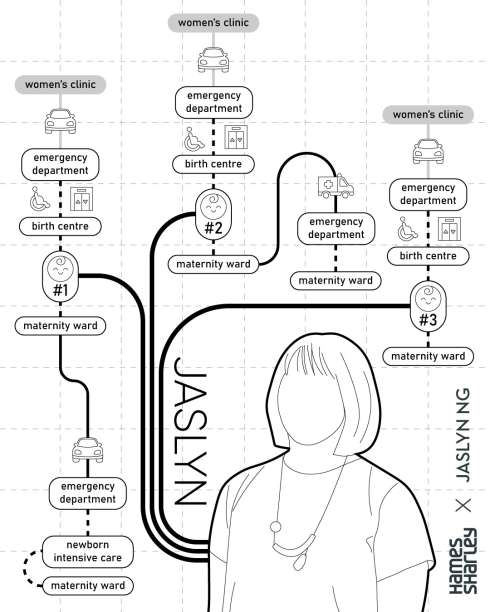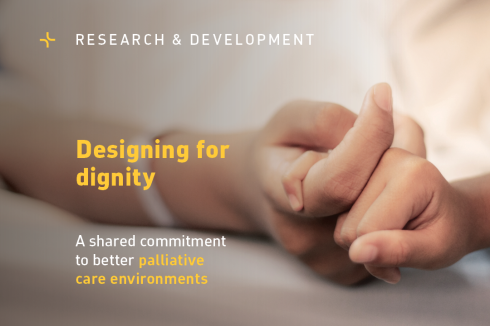
Map to motherhood
How diverse experiences inspire better design
“I’m drawn to debunking the motherhood myths, starting with my colleagues at Hames Sharley.”
A health facility will play a pivotal role at some stage in a person’s life, whether it is to celebrate the birth of a child, the death of a loved one or treatment of an illness. Over the past 15 years, research has conclusively demonstrated that the design of health facilities can positively impact the quality of care received by patients and influence their recovery rates.
Hames Sharley utilises knowledge gained from this research to ensure the health facilities we design promote speedy patient recovery, reduce length of stay, minimise risk, assist in the delivery of quality health care services and provide an efficient, satisfying workplace for health providers. By undertaking an evidence based design (EDB) approach, Hames Sharley has created an impressive track record in delivering innovative, efficient and responsive health facilities. We believe that the design of health facilities should be based on the mission and service delivery objectives of the health services to be provided.

Palliative care environments are among the most emotionally and physically demanding spaces in healthcare. The design of the physical environment is often overlooked or treated as a secondary concern, but it can be a powerful contributor to all occupants.

Hospitals are meant to be places of healing, yet for many patients, the very environments designed to support their recovery can make rest difficult. Sleep is often interrupted, natural light and its intensity is limited during the day, and often at night lighting and noise levels are too high – all of which can slow recovery and prolong hospital stays.

We all deserve to age in comfort, and to feel supported within an inclusive environment. But the built environment can be challenging to navigate for those who are sensitive to environmental stimuli, such as those living with neurogenerative diseases – though it needn’t be. In research led by Talia Uylaki, we explored how sensory-based design can lead to better outcomes for people living with dementia.

Hames Sharley’s Research team recently discovered a potential link between aggressive behaviour in Emergency Departments and spatial design, paving the way for a re-think of how these spaces are designed for clinicians, patients, visitors and the broader community.

By the time the design and construction of a new hospital is completed in Australia, it may already be outdated due to a lack of flexibility and the rapid development of technologies and services. Design and construction limitations were highlighted during the pandemic, with a pronounced shift from face-to-face services to remote telehealth services. While telehealth services continue to grow as important tools for providing care to our growing population, who knows what’s coming next?

Nowadays most of our time is spent indoors, so it’s vital to check the quality of our indoor environments. The importance of proper ventilation in support of indoor air quality (IAQ), for example, cannot be overstated in assessing the spaces we inhabit. Existing research suggests that poor ventilation may lead to increased indoor CO₂ levels that can cause cognitive function scores to drop significantly, and may be a key cause of tiredness, concentration problems, and even ill-health.
This research focused on the real-time monitoring of CO₂ levels in Hames Sharley’s new studio in Perth, Western Australia. Hames Sharley is committed to providing a quality workplace that optimises comfort, wellbeing, and productivity. This study provided the multidisciplinary design studio with the opportunity to assess its building’s performance and its responsiveness to the dynamics of a hybrid agile workplace setting through its real-time HVAC system sensor data.

Sometimes our worst experiences can be our best opportunity for growth. For Principal of People & Culture, Michael Wright, that was the case.
Michael shares his mental health journey in the hopes of encouraging ongoing conversations about everyday human struggles and how these experiences help us better understand our communities and each other.

Like many Australians, living through extended lockdowns has taken a toll on Fiona’s mental health.
Located in Victoria and currently going through lockdown number six, Fiona talks about why it’s so much harder to stay positive this time, and the lessons she’s learnt about the importance of self-care and social connections.

Thanks to a global health crisis, Director and National Portfolio Leader for Education, Science & Research, James Edwards, was forced to stay in Western Australia and catch up on some rather overdue medical tests. Despite having no symptoms, In April 2020, James was diagnosed with high-grade prostate cancer.

Having lost a close friend to suicide, Alex Quin has experienced first-hand the devastating impact mental illness can have on a community. In a bid to honour his friend, Phil, Alex writes about the need to de-stigmatise mental illness, and how the simple art of conversation can help those suffering feel less isolated.

When you think of designing for aged care, the use of light might not be the first thing that comes to mind. But a growing body of evidence suggests the clever use of lighting can have extraordinary effects on seniors’ health, safety and peace of mind.

The overcrowding of Emergency Departments (EDs) has been a serious issue facing many Australian hospitals for at least the last decade. It’s a complex issue resulting from multiple issues; from inadequate funding, to doctor shortages, and a scarcity of beds.